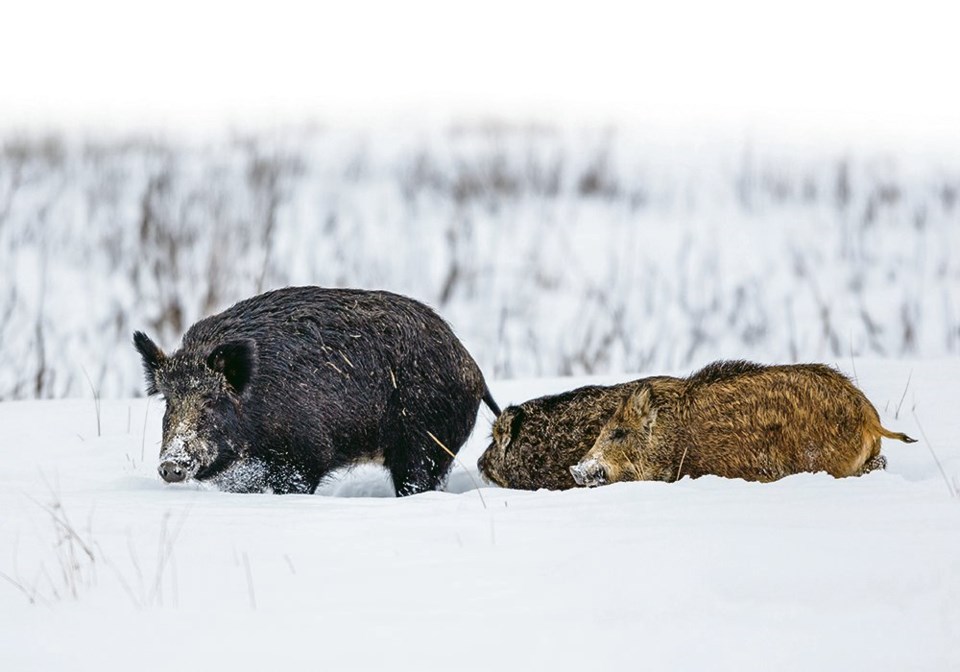WESTERN PRODUCER — Regulations under development in Saskatchewan will place wild pigs under the provincial Pest Control Act and allow people to use poison to kill them.
Premier Scott Moe announced at the Saskatchewan Association of Rural Municipalities conference last week that the regulations would also impose a moratorium on new wild boar farms and require licensing of existing farms. Funding available to the Saskatchewan Crop Insurance Corp. control program will be doubled to $200,000.
“They’re big, they’re bad and they’re not too pretty, and they create a host of problems wherever they arrive,” Moe said in his speech to delegates.
“Existing farms will be licensed; they’ll be grandfathered but no new farms will be approved in the future.”
SARM had asked for a moratorium as the problem of wild pigs seems to be growing across the province. But there was some rumbling in the crowd when Moe said farmers could use poison.
The Pest Management Regulatory Agency is looking at a product called Hoggone, which has been used in Australia for some time. However, it isn’t yet available.
During an open session with delegates, environment minister Warren Kaeding heard from people concerned about how further control will play out.
Kevin Abel, councillor from the RM of Lake Lenore, said his area is one of the “hearts” of the wild boar problem. He said landowners believed they weren’t able to trap a wild pig but that one of the teams employed by SCIC had to do it. He also wondered how the poison, if approved, would be distributed.
Kaeding said there is effectively an open season on wild boar but they are difficult to catch.
Hoggone is undergoing final registration from PMRA and is effective only on the porcine species.
“It blocks an enzyme that’s just specific to the hog species,” Kaeding said.
The minister said there hasn’t yet been discussion about distribution but it would likely be done through RM pest control officers and municipal offices similar to products like strychnine.
An RM pest control officer said she was concerned at hearing the word poison but after googling Hoggone she felt better about it.
Ryan Brook, a University of Saskatchewan professor who has studied wild pigs, said the animals are a serious risk to agriculture wherever they establish.
“Hoggone is the best available poison option for wild pigs in my view because it is a sodium nitrite-based poison that is fast acting and pigs are highly susceptible to it due to pigs having considerably less of the enzyme that breaks down sodium nitrite than most other animals,” Brook said.
But he noted that the poison can’t be just placed out in the open because efforts to prevent non-target species from ingesting it are still underway.
“Much progress has been made in sorting this out by having heavy metal lids that wild pigs can open but most other species cannot,” he said.
Brook said the other challenge is to make a group of 12 pigs, for example, all get enough poison to cause a humane death. Multiple sites to distribute the poison in an area would be required.
He also said Australia has been using Hoggone for a while and a recent estimate suggested there are still 23 million wild pigs in that country.
“Clearly wild pigs are a tremendous challenge to reduce or eliminate when they are already firmly established (as they are on the Canadian Prairies) and there is no one single tool that will get it done,” he said.
Brook said Saskatchewan requires a comprehensive strategy to deal with the problem because piecemeal efforts will have limited short-term effect.
Kaeding agreed that Hoggone, if approved, won’t be the only control method.
“Before it’s fully registered everyone wants to have a full comfort level that this is not something that’s going to be damaging, long-lasting, stay in the environment, accumulate, all of those things that we’ve been through with other products,” he said. “Right now, live trapping is by far our best and most valuable resource to deal with wild boar and I would say we just need to explore all the tools in the toolbox.”
Meanwhile, agriculture minister David Marit said the regulations will include a way to ensure existing farmers abide by all the rules to keep wild boar contained.
“Our officials have told me it’s between 15 and 20 (farms),” he said.
According to officials, SCIC paid out 13 claims worth $47,000 last year. There were 22 sightings in the last year but an estimated 50,000 pigs are roaming the province.
Feral pigs are invasive and can cause significant damage to crop land and natural areas. There is concern that the population could become a reservoir for African swine fever, which hasn’t yet been found in North America but is in wild populations in other places.

